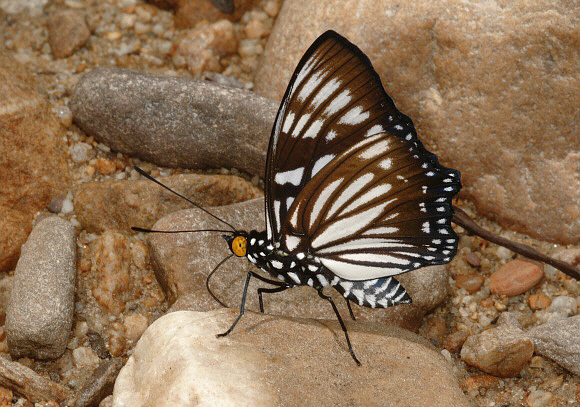
Introduction
The Golden-eye, also known as the Courtesan, is one of 3 members of the genus Euripus, which is placed in the Apaturini – the same tribe to which the Purple Emperor of Europe belongs.
The male, illustrated above, is regarded as a Batesian mimic of the male of Euploea radamanthus, a Danaine which has a similar pattern of white rays in its underside. This Danaine, known as the Magpie Crow, has been demonstrated to be toxic to birds, and is mimicked by several non-toxic butterflies including nyctelius and the Papilionid Chilasa paradoxa.
The female of nyctelius produces 2 distinct forms or morphs – f. isina, on the upperside is marked with white bars on a black ground colour, again just like the male of Euploea radamanthus. Another of the nyctelius female morphs is euploeoides, which as its name suggests is also a Euploea mimic, but in this case it is imitating the female of radamanthus, which has extensive areas of white on its hindwings. Both sexes of nyctelius possess distinctive golden-yellow eyes.
Euripus nyctelius is found in Sikkim, Myanmar, Thailand, West Malaysia, Singapore, the Philippines, Sumatra, Borneo and Java – a range that coincides exactly with that of Euploea radamanthus.
Habitats
This species is found in primary rainforest at elevations between sea level and about 500 metres.
Lifecycle
I have no information about the egg stage, but based in related genera it is likely to be spherical and laid singly on leaves of the foodplant. The larva is green with a series of pale diagonal stripes along the sides. It is plump, and tapers strongly towards the tail. The head is adorned with a pair of forward curving horns. It feeds nocturnally on Gunpowder tree Trema orientalis ( Cannabaceae ). The chrysalis is pale green with whitish diagonal stripes along the sides, and bears a remarkable resemblance to a leaf, complete with a “midrib” and “veins”. It is suspended by the cremaster from a leaf of the foodplant.
Adult behaviour
Males are not uncommon but are elusive in behavior. They tend like other Apaturini to spend most of their time on territorial perches high in the tree tops, and give chase to other males which enter their domain. Occasionally they descend to imbibe mineralized moisture from pebble-strewn river beaches. Females are seen much less frequently, usually when flying around low vegetation.
